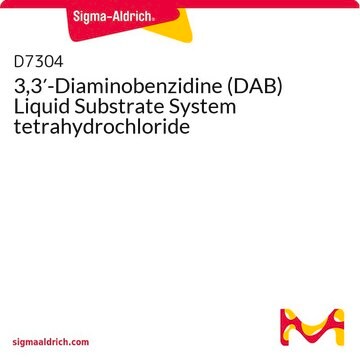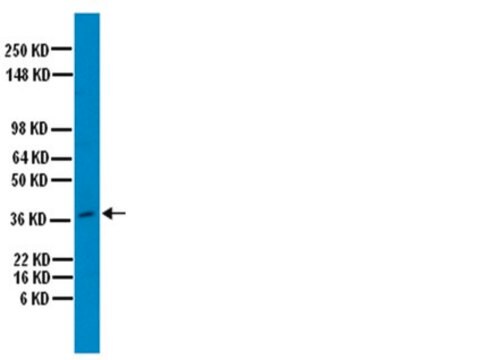おすすめの製品
由来生物
rabbit
品質水準
抗体製品の状態
serum
抗体製品タイプ
primary antibodies
クローン
polyclonal
交差性
rat, human
メーカー/製品名
Chemicon®
テクニック
ELISA: suitable
immunocytochemistry: suitable
immunohistochemistry (formalin-fixed, paraffin-embedded sections): suitable
radioimmunoassay: suitable
western blot: suitable
NCBIアクセッション番号
UniProtアクセッション番号
輸送温度
wet ice
ターゲットの翻訳後修飾
unmodified
遺伝子情報
human ... IBSP(3381)
rat ... Ibsp(24477)
詳細
Bone sialoprotein II is one of the major noncollagenous proteins in the extracellular matrix of bone. It is a phosphorylated glycoprotein with an approximate molecular weight of 70 kDa. The protein has been found in osteoblasts and osteocytes. Diseases concerning the bone turnover, pathological bone alterations as well as the rapid increase of osteoporosis make it necessary to establish new markers, Bone sialoprotein is discussed as a potential serum marker for monitoring bone remodelling.
特異性
Human and rat Bone sialoprotein (BSP). No cross reactivity with human osteopontin or osteonectin by RIA or ELISA.
Other species have not been tested
アプリケーション
Anti-Bone Sialoprotein II Antibody is an antibody against Bone Sialoprotein II for use in ELISA, IC, IH, IH(P), RIA & WB.
Western Blot
Immunohistochemistry (Paraffin) (see suggested protocol below)
Immunocytochemistry (1:100)
RIA
ELISA
Optimal working dilutions must be determined by the end user.
SUGGESTED STAINING PROCEDURE FOR RABBIT ANTI-BONE SIALOPROTEINAB1854
This protocol has been used successfully on 5 um, paraffin embedded sections from human fetal tibia, human fetal calvaria, human metastatic breast tumors to bone which were decalcified in 10% formic acid.
1. Dewaxing: Xylene 5 min. - Xylene 5 min. - Xylene 5 min.
2. Rehydration: 100% ethanol for 3 min. - 95% ethanol for 3 min. - 70% ethanol for 3 min.
3. Wash sections under running tap water for 5 minutes.
4. Wash sections in PBS.
5. Block endogenous peroxidase: 0.3% hydrogen peroxide in absolute methanol (2 mL of H2O2 30% in 198 mL methanol) for 30 minutes. (Cover the jar with foil, use stirring during incubation.)
6. Wash sections under running tap water for 10 minutes.
7. Mark tissue area with pap pen.
8. Cover the tissue area with 300 mL of blocking solution for 30 minutes at room temperature (blocking solution: 6 mL PBS, 0.3 gm BSA, 120 mL normal goat serum).
9. Shake off excess fluid (do not wash).
10. Incubate with primary antibody (AB1854 diluted 1:2,500 in PBS-T) at 2-8°C overnight in moist chamber.
11. Rinse with PBS-T, then wash 3 times in PBS-T each for 5 minutes at room temperature.
12. Incubate with biotinylated secondary antibody (for example Chemicon AP132B) for 30 minutes at room temperature.
13. Rinse with PBS-T, then wash in PBS-T 3 x 5 minutes at room temperature.
14. Incubate the sections with Vector ABC reagent for 30 minutes at room temperature. (ABC reagent: 2 drops of A and 2 drops of B, in 5 mL PBS, allow to stand 30 minutes at room temperature before use.)
15. Wash sections in PBS 3 x 5 minutes at room temperature.
16. Develop with DAB for 5-10 minutes.
17. Wash under running tap water.
18. Counter stain with Mayer′s HX for 45 seconds, wash in warm tap water.
19. Dehydrate: 70% ethanol - 95% ethanol - 100% ethanol, 1 min. each.
20. Wash in Xylene, mount, dry.
Immunohistochemistry (Paraffin) (see suggested protocol below)
Immunocytochemistry (1:100)
RIA
ELISA
Optimal working dilutions must be determined by the end user.
SUGGESTED STAINING PROCEDURE FOR RABBIT ANTI-BONE SIALOPROTEINAB1854
This protocol has been used successfully on 5 um, paraffin embedded sections from human fetal tibia, human fetal calvaria, human metastatic breast tumors to bone which were decalcified in 10% formic acid.
1. Dewaxing: Xylene 5 min. - Xylene 5 min. - Xylene 5 min.
2. Rehydration: 100% ethanol for 3 min. - 95% ethanol for 3 min. - 70% ethanol for 3 min.
3. Wash sections under running tap water for 5 minutes.
4. Wash sections in PBS.
5. Block endogenous peroxidase: 0.3% hydrogen peroxide in absolute methanol (2 mL of H2O2 30% in 198 mL methanol) for 30 minutes. (Cover the jar with foil, use stirring during incubation.)
6. Wash sections under running tap water for 10 minutes.
7. Mark tissue area with pap pen.
8. Cover the tissue area with 300 mL of blocking solution for 30 minutes at room temperature (blocking solution: 6 mL PBS, 0.3 gm BSA, 120 mL normal goat serum).
9. Shake off excess fluid (do not wash).
10. Incubate with primary antibody (AB1854 diluted 1:2,500 in PBS-T) at 2-8°C overnight in moist chamber.
11. Rinse with PBS-T, then wash 3 times in PBS-T each for 5 minutes at room temperature.
12. Incubate with biotinylated secondary antibody (for example Chemicon AP132B) for 30 minutes at room temperature.
13. Rinse with PBS-T, then wash in PBS-T 3 x 5 minutes at room temperature.
14. Incubate the sections with Vector ABC reagent for 30 minutes at room temperature. (ABC reagent: 2 drops of A and 2 drops of B, in 5 mL PBS, allow to stand 30 minutes at room temperature before use.)
15. Wash sections in PBS 3 x 5 minutes at room temperature.
16. Develop with DAB for 5-10 minutes.
17. Wash under running tap water.
18. Counter stain with Mayer′s HX for 45 seconds, wash in warm tap water.
19. Dehydrate: 70% ethanol - 95% ethanol - 100% ethanol, 1 min. each.
20. Wash in Xylene, mount, dry.
物理的形状
Lyophilized. Resuspend in 100 μL aqua bidest. Contains no preservatives.
保管および安定性
Maintain at 2-8°C (lyophilized) or -20°C (reconstituted) for up to 6 months in undiluted aliquots. Avoid repeated freeze/thaw cycles.
法的情報
CHEMICON is a registered trademark of Merck KGaA, Darmstadt, Germany
適切な製品が見つかりませんか。
製品選択ツール.をお試しください
保管分類コード
10 - Combustible liquids
WGK
WGK 1
引火点(°F)
Not applicable
引火点(℃)
Not applicable
適用法令
試験研究用途を考慮した関連法令を主に挙げております。化学物質以外については、一部の情報のみ提供しています。 製品を安全かつ合法的に使用することは、使用者の義務です。最新情報により修正される場合があります。WEBの反映には時間を要することがあるため、適宜SDSをご参照ください。
Jan Code
AB1854:
試験成績書(COA)
製品のロット番号・バッチ番号を入力して、試験成績書(COA) を検索できます。ロット番号・バッチ番号は、製品ラベルに「Lot」または「Batch」に続いて記載されています。
Loss of MMP-2 in murine osteoblasts upregulates osteopontin and bone sialoprotein expression in a circuit regulating bone homeostasis.
Mosig, RA; Martignetti, JA
Disease models & mechanisms null
Y-C Huang et al.
Gene therapy, 12(5), 418-426 (2005-01-14)
Gene therapy approaches to bone tissue engineering have been widely explored. While localized delivery of plasmid DNA encoding for osteogenic factors is attractive for promoting bone regeneration, the low transfection efficiency inherent with plasmid delivery may limit this approach. We
Bone grafts engineered from human adipose-derived stem cells in perfusion bioreactor culture.
Fr??hlich M, Grayson WL, Marolt D, Gimble JM, Kregar-Velikonja N, Vunjak-Novakovic G
Tissue Engineering: Part A null
Preparation and characterization of mesoporous bioactive glass/polycaprolactone nanofibrous matrix for bone tissues engineering.
Hsiu-Mei Lin,Yi-Hsuan Lin,Fu-Yin Hsu
Journal of Materials Science. Materials in Medicine null
Characteristics of periodontal ligament subpopulations obtained by sequential enzymatic digestion of rat molar periodontal ligament.
T Kaneda, M Miyauchi, T Takekoshi, S Kitagawa, M Kitagawa, H Shiba, H Kurihara, T Takata
Bone null
ライフサイエンス、有機合成、材料科学、クロマトグラフィー、分析など、あらゆる分野の研究に経験のあるメンバーがおります。.
製品に関するお問い合わせはこちら(テクニカルサービス)








